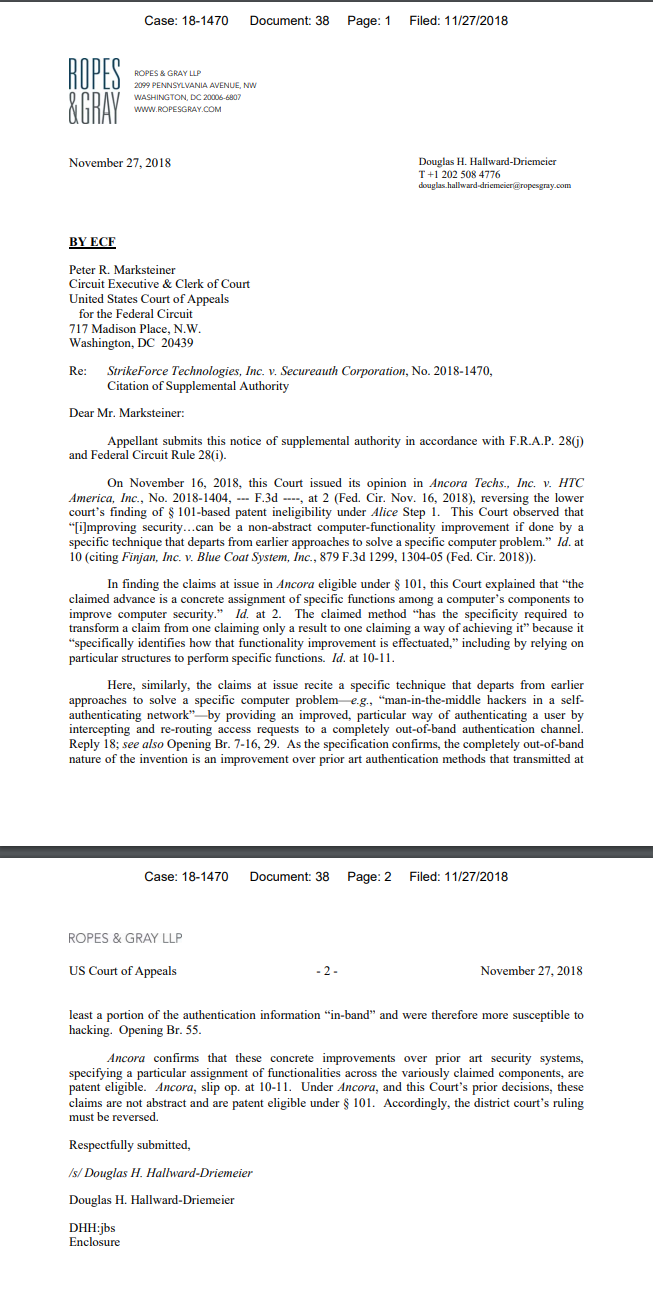Very very interesting CP!!! Excellent find. Now, c
Post# of 82692
Two Recent Federal Circuit Decisions Reinforce the Path to Success on Section 101 Challenges to Software Patents
The cases help highlight the optimal approaches for practitioners on either side of the caption. By Bill Sigler January 8, 2019
Since the Supreme Court’s landmark 2014 Alice Corp. v. CLS Bank decision, the Federal Circuit’s application of the Alice test has taken a number of twists and turns. Over the past year, though, the court’s approach to Section 101 challenges to software patents has come into sharper focus. Two recent precedential decisions—Data Engine Technologies LLC v. Google LLC, 906 F.3d 999 (Fed. Cir. 2018) and Ancora Technologies , Inc. v. HTC America , Inc., 2018 WL 6005021, --- F.3d ---- (Fed. Cir. Nov. 16, 2018)—help highlight the optimal approaches for practitioners on either side of the caption.
In each of these cases, the Federal Circuit reversed the district court’s Alice step-one conclusion that the claims-at-issue were directed to an abstract idea. The Federal Circuit did so because it found that the claims were directed to a specific technological solution to a specific problem in the prior art. As it did in other recent decisions, the court relied heavily on the intrinsic evidence’s discussion of this solution and problem.
More specifically, in Data Engine, the Federal Circuit cited the specification’s identification of the problem in the prior art of navigating through three-dimensional or multi-page electronic spreadsheets. It explained that a representative claim of one patent-in-suit was eligible because it recited “a specific structure (i.e. notebook tabs) within a particular spreadsheet display that performs a specific function” solving this problem. And similarly, in Ancora , the court traced the specification’s discussion of the problem in the prior art of identifying and restricting unauthorized software use. The Federal Circuit concluded that the claims-at-issue were directed to solving that problem through a “structure containing a license record [] stored in a particular, modifiable, non-volatile portion” of memory .
So for patentholders, the preparation for withstanding a Section 101 challenge should begin before filing the case. Given the prevalence of such challenges, plaintiffs would be wise to select patents for assertion that describe a specific problem in the prior art and a specific advancement that solves this problem. This description is typically found in the specification, but the file history may provide an additional resource. For instance, the Federal Circuit relied on articles praising the invention that appeared in the file history in the Data Engine case. Plaintiffs would also be wise to assert claims that expressly incorporate the specific technological solution described in the specification.
On the flip side, these and other recent decisions establish that challengers must do far more than argue that the claimed idea was long known or analogous to some other real-world solution . Indeed, the Federal Circuit stated in Data Engine, “It is not enough . . . to merely trace the invention to some real-world analogy.” Instead, defendants should attack the intrinsic record’s failure to disclose a specific solution to a specific problem. Kaavo, Inc. v. Amazon.com Inc., 323 F. Supp. 3d 630 (D. Del. 2018) provides a successful example of this approach in the District of Delaware, with Chief Judge Leonard P. Stark finding that the specification didn’t “discuss any technological problems in the field nor explain how the claimed invention provides an unconventional technological solution.” But if that argument can’t credibly be advanced, a defendant can still succeed by showing that the claim-at-issue isn’t limited to the disclosed solution. The Federal Circuit in Data Engine found that other claims were ineligible for this very reason.
Bill Sigler is a partner in Fisch Sigler LLP’s Washington, DC office.
Now review Ropes & Gray's Supplemental authority:

 (15)
(15) (0)
(0)